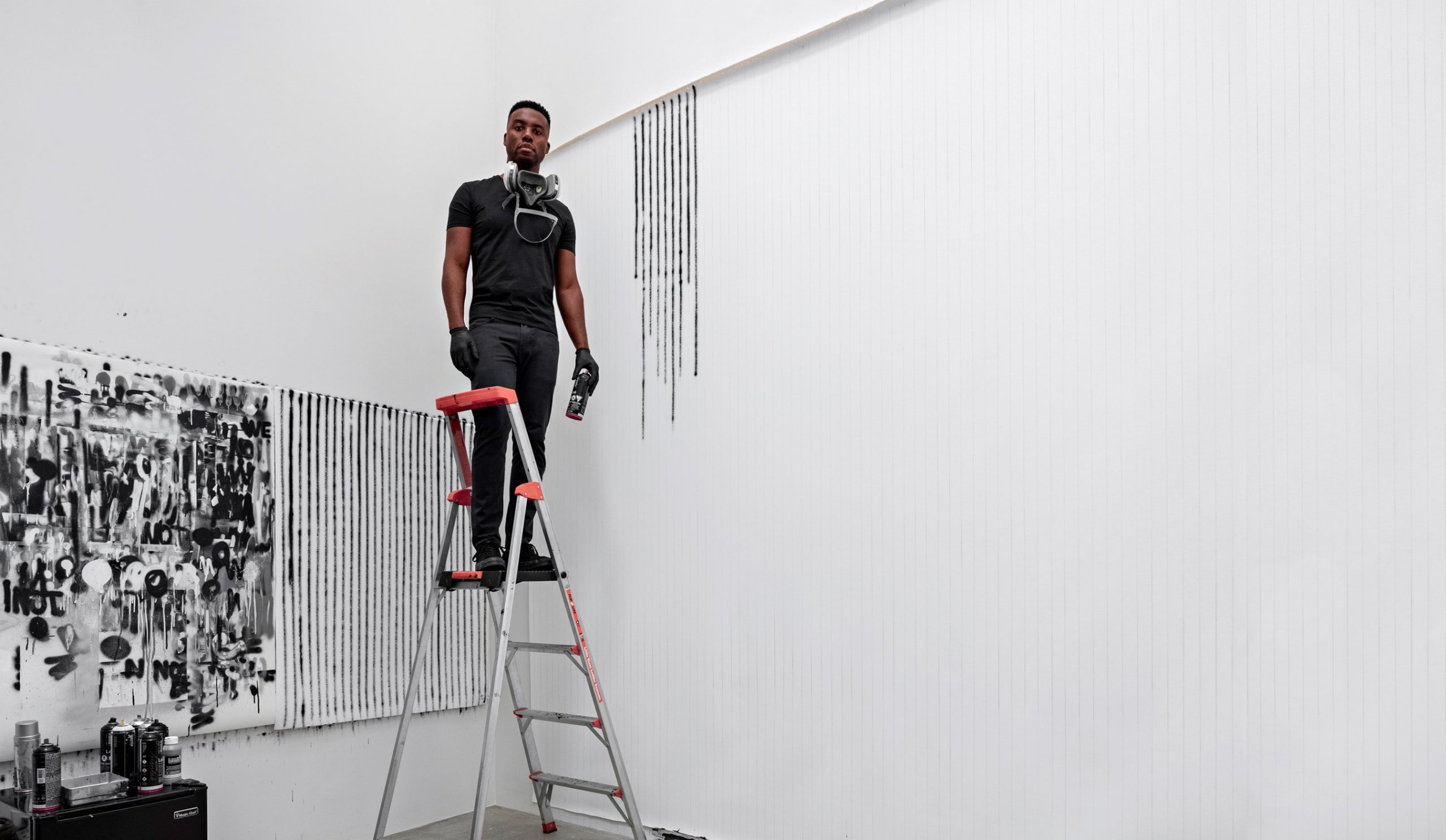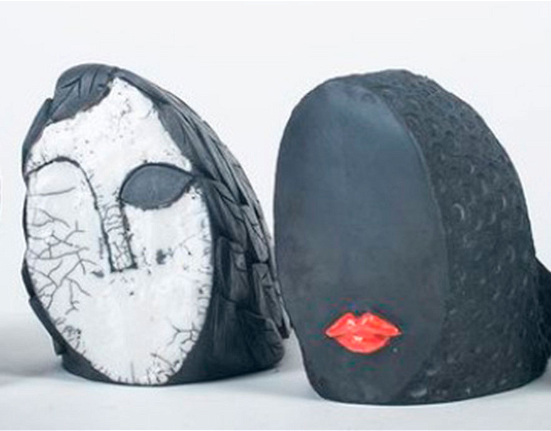Photo: Matthew Placek, Courtesy the artist
On October 9, as an unfolding escalation in Israel-Palestine reverberated across the globe, I found myself in front of Adam Pendleton’s studio in Wallabout, Brooklyn, a mere stone’s throw from the New York Harbor. On entering the workspace filled with soft light, minimalist furniture, and an aroma of freshly cut flowers and pungent acrylic spray paint, the world briefly appeared organized, clear, and free from the constant need to check the ever-worsening, chaotic news.
Pendleton sat upright behind a white lacquered desk in the backroom office. His words were measured and deliberate as he explained the working hypothesis behind his art, “Black Dada.” In his view, this term encapsulates the relationship between blackness, abstraction and avant-garde art. “It was initially a kind of conceptual position that I function from as an artist,” he said. It also encompasses theoretical outlooks that have shaped his practice, including those of philosopher Fred Moten, queer theorist Judith Butler, and filmmaker Jean-Luc Godard. All are represented in a small, organized library, in a side room of the artist’s studio.
But what does Black Dada actually do? Pendleton emphasized its role in approaching language, exhibition making, painting, and drawing. He spoke of it as dynamic force that extends to categorization, but one that also blurs temporal lines between past, present, and future. “As a concept, Black Dada is generative, even generous. It opens up the same freedom and flexibility for the viewer as it does for me as an artist,” he explained. Using spray paint and screen printing, Pendleton creates works that often merge language and image, challenging the ways in which it shapes or distorts our self-perception.
Installation view Adam Pendleton. “Blackness, White, and Light.” Photo: Klaus Pichler, © mumok
His monumental solo exhibition at the Mumok, a preeminent museum in Vienna, “Blackness, White, and Light” (until January 7, 2024), is a prime example of this. In the exhibition’s luminous atrium, the artist’s large-scale paintings are provided with ample breathing space, allowing visitors to fully immerse themselves. “The idea was that everything is integrated,” the artist said. “The experience of the exhibition itself is akin to what one could see when standing in front of the paintings or the drawings.”
Observing those works in detail, there is an immediate sense of tension between proximity and distance, of black and white, of cold abstraction and concrete poetry. Echoes of modern art history emanate. Influences of artists like Cy Twombly, Jack Whitten, and Ed Clark seem evident, as does an experimental directness recalling the works of Jean-Michel Basquiat, or a geometric sensibility in the vein of Agnes Martin or Ann Truitt. Unlike the Abstract Expressionists, who sought to externalize the internal, Pendleton encapsulates what he finds on the outside: a corner, a word, or a sentence. His works feel like minimalist reflections of everyday life, stripped down to the essentials.
At 39, the artist has amassed a significant body of work, which spans drawing, painting, sculpture, and film. In addition to the current exhibition at the Mumok, Pendleton has recently opened shows at the Kemper Art Museum in St. Louis, as well as the Tegnerforbundet Drawing Center in Oslo, and is now actively gearing up for upcoming gallery displays, including one slated for Max Hetzler’s London gallery. At a recent solo exhibition at MoMA, called “Who Is Queen?” (2021), he explored the possibility of a life beyond labels. The show was often interpreted as a response to his artistic engagement with the Black Lives Matter movement and it also provided a pivotal moment in his career: a massive, grid-like installation towering nearly 18 meters (60 feet) served as a framework for his characteristic black and white paintings. Pendleton relishes in grandeur.
Installation view Adam Pendleton. “Blackness, White, and Light.” Photo: Klaus Pichler, © mumok
Some of his paintings and drawings isolate words or letters from original contexts. In some there is simply a letter, like or cropped off syllable, “BLA.” A striking painting prominently displayed at the Mumok, repeatedly states: “WE ARE NOT.” This persistent negative leaves the viewer wondering what is encapsulated both in the “not,” but it also hangs a question mark over who Pendleton may mean by “we.” Are these references to the Black community, forced to resist white impositions? Or is it an allusion to a queer disavowal of normative expectations? Is it rather to bring to focus an inherent incongruity of the artistic “we” with the expectations held by others? Pendleton remained elusive. “I find it interesting to ask, ‘Who is the We?’,” he noted, “but the paintings don’t seek to answer that. The idea is to position ideas around representation through negation.”
For the artist, abstraction is a vehicle for experimentation. In addition to his art, he has created several anthologies that include interviews with familiar luminaries, including the filmmaker Yvonne Rainer or queer theorist Jack Halberstalm. These discussions offer insights into Pendleton’s own process as well as broader perspectives that can inform a reading of the work.
At the pulsating core of the Mumok show are a number of the artist’s films, which exemplify the ethics behind Black Dada. They show eerily lit dance sequences, a starkly aestheticized and almost grotesquely decelerated black-and-white depiction of a figure in a swimming pool, as well as several interviews. Among the latter are intimate conversations with Black civil rights activist Ruby Nell Sales, and choreographer Kyle Abraham, for instance. Personal narratives seemingly weave into a political tapestry. Vulnerability, community, and struggle are recurring themes. “I was struck by a simple question from Ruby Nell Sales,” Pendleton recalled. “‘Where does it hurt?’. I found that this was such a tender and profound question to ask of an individual, but also of us as a collective. I think what she meant was the relationship to America. But I like to think of it as a universal question.”
Adam Pendleton
Black Dada (A/D), (2022–23) © Adam Pendleton, courtesy of the artist
Identity is another lingering theme, but Pendleton deflected any focus on it when pressed on the subject and firmly denies that a heightened sensitivity to identity-related questions has influenced his art making. His pieces, he asserted, are an authentic reflection of the material. His creative expression would be compromised if he followed expectations—be it of his audiences or of the art market.
In the Mumok show, his films are displayed within maze-like structures that are strikingly angular—shapes reminiscent of Le Corbusier. They create a stark contrast within the white cube setting, and mimick the use of geometric elements in Pendleton’s paintings. A separate room features drawings, which include words, drops, subtle dabs, and splashes. His “Untitled (Days)” series (2021–ongoing) incorporates remnants of paper sheets stenciled with circular and line forms. They seem to trace visual positions with a focus on graphic motifs. “You could call it a discursive index,” Pendleton said. “Both vague and explicit at the same time.” He described the dynamic between painting and drawing as ever-changing. In painting, he suggested, elements come together in a more distinct way and at a slower pace. Drawing, on the other hand, is quicker, even though Pendleton acknowledged that lines can blur: “I often find myself drawing while painting.”
Asked whether it would be fair to say that he is currently moving away from words and more towards abstraction, he said: “A little bit, but it is much more ‘both-and’ instead of ‘either-or.’” His answer not only explains an art practice, but it might also be useful to keep in one’s mind amid the political debates swirling in recent weeks. While he might be reluctant to admit it, the artist’s engagement with politics excels beyond the canvas or his studio. His recent involvement in raising nearly $6 million to preserve musician Nina Simone’s childhood home shows his profound commitment to social causes. Emphasizing his interest in community building, he replied simply and clearly: “If you can do something, do it.”
More Trending Stories:
Masterpiece or Hot Mess? Here Are 7 Bad Paintings by Famous Artists
Who Won Auction Week? Here Are 9 Takeaways From New York’s Nearly $2 Billion Fall Sales
Kurt Cobain’s Old Jeans Just Set an Auction Record for Levi’s
Seller’s Remorse: How a Thrift Store Owner Let a $191,000 Painting Slip Through His Fingers for $4
A Prankster Used A.I. to ‘Improve’ Edward Hopper’s Classic ‘Nighthawks’
Chinese Artist Chen Ke Celebrates the Women of Bauhaus in a Colorful, Mixed-Media Paris Debut
A Centuries-Spanning Exhibition Investigates the Age-Old Lure of Money
Meet the Woman Behind ‘Weird Medieval Guys,’ the Internet Hit Mining Odd Art From the Middle Ages
Follow Artnet News on Facebook:
Want to stay ahead of the art world? Subscribe to our newsletter to get the breaking news, eye-opening interviews, and incisive critical takes that drive the conversation forward.







